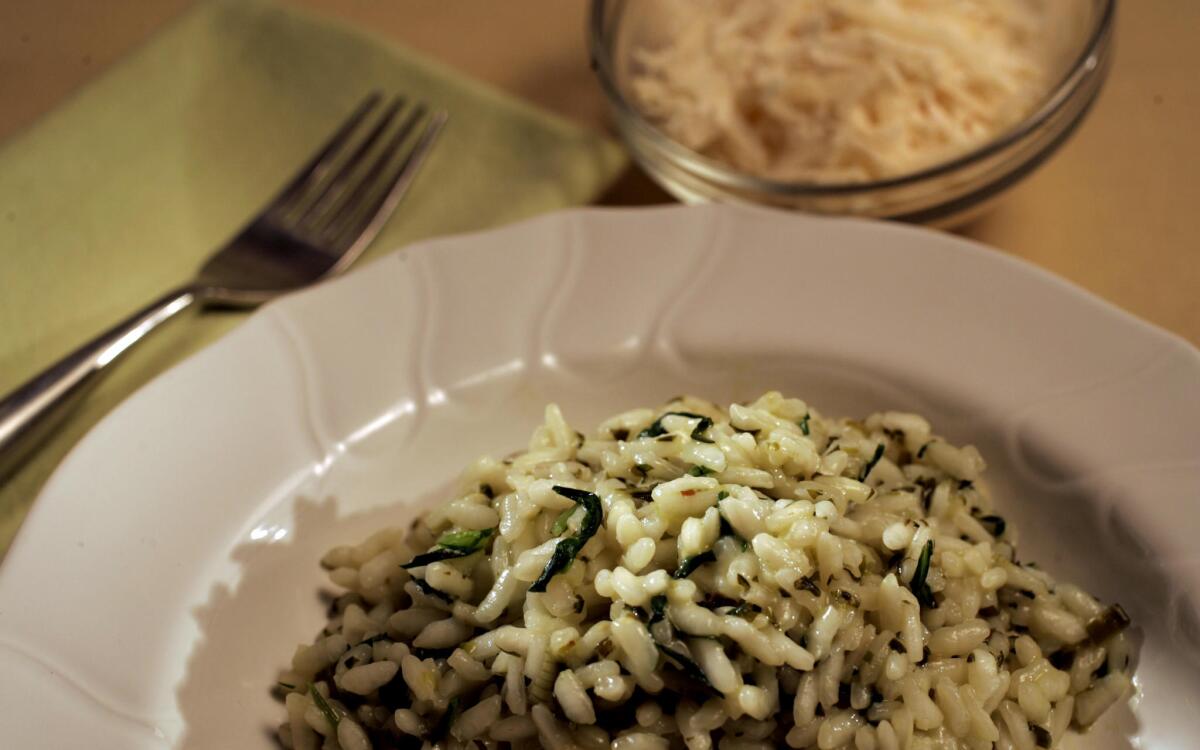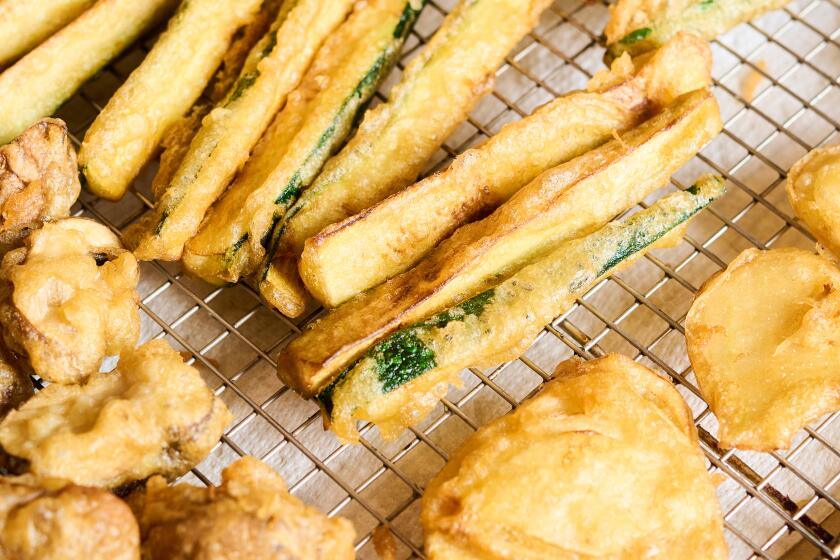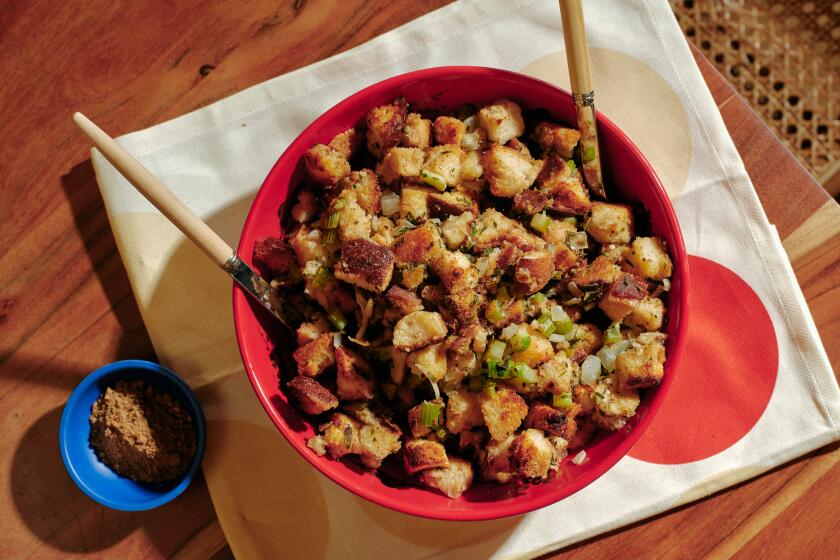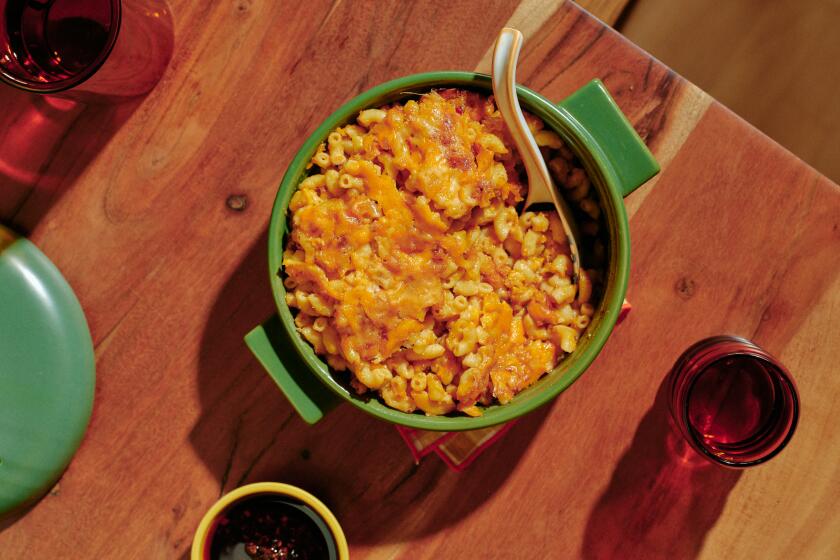Risotto with spring herbs

THEY used to be names that we Italophiles whispered to each other in the dark like the passwords of a secret cult: âCarnaroli,â âVialone Nano,â âSuperfino!â While other risotto-loving Americans were satisfied with arborio, which almost anyone could get at a good gourmet store, we prided ourselves on our hoarded supplies of the real stuff, the secret rices of Italy.
We could be pretty danged smug about it too. If a friend was going to Italy, we might beg them to bring us âa fewâ boxes, knowing full well that each weighed a standard 1 kilogram or 2.2 pounds. Sometimes I think we asked as much to demonstrate our superior knowledge as to actually get the rice. Such is the intoxicating lure of caring passionately about things that few others do.
So you can imagine how I felt when I walked into my local fancy grocery the other day and found, sitting prettily on the shelf, a box of Vialone Nano. At first I was aghast: the secret rice of Venice offered to uninitiated members of the public as if it were nothing more than Uncle Benâs?
But then I started thinking about how long it had been since I had made risotto, and wondering whether it was time for a personal revival.
There couldnât be a better time of year than now to rediscover risotto. One of the ironies of the dish is that although it is so marvelously complex in flavor that you might believe all of the fuss about how difficult it is to prepare, risotto is essentially extremely simple: rice, main ingredient and broth. Add a flavoring base to start out, a little wine in the middle, and some butter and cheese to finish and youâve just about covered every possibility.
Because of this simplicity, risotto is the perfect vehicle for the flavors of spring, which are by nature more delicate than the rowdy tomatoes and peppers weâll be enjoying in just another couple of months. Artichokes, asparagus, peas and wild mushrooms -- there are at least half a dozen risotto combinations from just that list of ingredients.
But risottoâs simplicity also makes demands. You have to use the right rice -- arborio, Carnaroli or Vialone Nano are the ones most available in the U.S. -- to get the distinctive creaminess of the dish.
Each of the trio has its fans -- even its fanatics. But while there are certainly differences among them, donât let not finding that one special rice scare you away from making risotto. The three can be used interchangeably with fairly similar results.
Itâs more like the variations among good brands of dried pasta than the difference between, say, regular long-grain and fragrant basmati. There are differences in texture, but not in taste. In fact -- this may get me kicked out of the risotto cult -- but there is absolutely nothing wrong with plain old arborio (which, by the way, is now sold at my neighborhood supermarket).
*
Ideally suited
WHAT makes these rices perfect for risotto is the way they are built. Like all rices, they are made primarily of starch: amylopectin and amylose. Amylopectin is a soft starch that dissolves readily in liquid; amylose is a hard starch that resists dissolving.
Risotto rices contain far more amylopectin than most rices, though not as much as sticky Japanese sushi rice. When they are cooked properly, the soft starch leaks out and thickens the broth, forming what my friend, food and wine writer Matt Kramer, calls âthe sauce within.â
Generally, arborio and Carnaroli, which are graded superfino, are a little higher in amylose (though certainly not higher than long-grain rice). Their large, meaty kernels remain a little firmer (particularly Carnaroli), though they may tend to be a little stickier (particularly arborio). Vialone Nano, which is fino, is softer and thickens the broth a little less, making it perfect for the slightly soupier style of risotto preferred in Venice. (Locals refer to that texture as allâonda, meaning it moves âlike a waveâ).
Rice preferences in Italy are highly regional, and reflect how risotto is made in the area. Vialone Nano may be regarded as the only rice in the Veneto, but in Piemonte, Lombardia and Emilia-Romagna, they prefer their risottos a little stiffer and so they feel equally strongly about Carnaroli and arborio. Discussing risotto with a Piemontese chef the other day, he summed it up nicely: âI use Carnaroli. If I canât get Carnaroli, I use arborio. If I canât get arborio, I donât make risotto.â
There is another risotto rice called Baldo, rarely seen in the U.S. Like arborio and Carnaroli, it is graded superfino, but from what Iâve seen, it doesnât seem to offer enough advantages to make it cult-worthy. It is attracting a small following among chefs in Italy because it cooks a little more quickly, making it easier to serve in a restaurant setting. Iâve heard some chefs say they prefer Vialone Nano for a similar reason -- its slightly lower amylopectin content means it doesnât get sludgy when it sits as quickly as arborio or Carnaroli.
With risotto, the rice is the thing and you donât want to overshadow it. But more important than the specific type of rice you use is paying attention to technique and to the balance of ingredients.
One of the most common mistakes people make when fixing risotto is the choice of liquid they add. Partly this is a misunderstanding of terms: Americans tend to use the words âbrothâ and âstockâ interchangeably, but an Italian brodo (broth) is much lighter in flavor than a French-style stock. Make risotto with a French-style stock and stock is all you will taste. It would be better to use plain water.
While a good homemade broth will certainly make an exquisite risotto, you can do amazingly well with good-quality store-bought chicken broth thinned with water (do not use it straight). If you have trimmings from the main ingredient -- say, asparagus peels, pea pods or shrimp shells -- simmer them with the broth to add an extra dimension of flavor.
Much has been made about the technique of making risotto: the supposed necessity of adding the stock in tiny amounts, the constant stirring, the muttered incantations. For the most part, these are overblown (except the last one).
Risotto making can be broken into four stages. An Italian cook I worked with gave them the names of the appropriate infinitive verbs, making a recitation sound like one of Danteâs cantos: soffriggere, tostare, bagnare, mantecare (the four circles of risotto?).
*
The four basics
THIS is much more impressive in Italian than English. It really only describes four very basic operations: creating the flavor base (soffriggere, to fry softly); toasting the rice (tostare, to toast); cooking the rice (bagnare, to bathe); and beating in the final addition of butter and cheese (mantecare, to beat in fat -- what a joyous language to have a specific word for that!).
Weâll take each step at a time. All risottos start with some kind of flavor base, frequently nothing more than onions and butter or olive oil melted together over medium-low heat. You can add firm vegetables such as artichokes or the fat parts of asparagus at this point as well. Cook just until the ingredients start to shine. Do not let the onions brown.
Add the rice and stir to coat it with the flavoring base. Increase the heat to medium and keep stirring until you hear the rice âsingingâ as it scrapes against the bottom of the pan.
This sets the outer shell of the rice so it will stay firm and wonât get too mushy. You can actually see this happening: The outer perimeter of the kernel will turn translucent.
The first measure of liquid you add should almost always be wine. It doesnât take very much, but you need to have some degree of tartness in the background (especially considering all that mantecazione youâre going to do at the end).
The wine will cook away in just a couple of minutes. Now begin adding the hot broth. The broth must be kept at a simmer the whole time. Adding cold broth to the rice or not keeping your risotto pan at a high enough temperature will delay the cooking and result in a gummy risotto.
The first addition of the broth can be as much as one cup or even a little more. And after youâve given the broth a quick stir to distribute the rice, you donât really need to stir again until the broth is almost gone.
Youâll know when to add more broth when you can see a clean track in the bottom of the pan when you stir. With the second addition, reduce the amount of broth just a little. And again, once youâve stirred the rice, you donât need to pay too much attention.
*
Third timeâs a charm
WHEN you can again see the clean track in the bottom of the pan, itâs time for the third addition. And this is where you need to start paying attention.
Add about one-half to three-quarters cup of stock, and when that is almost gone, taste the rice.
A properly made risotto will be slightly chewy rather than mushy, but there should be absolutely no crunchy, uncooked starch left in the kernel.
Right before you stir in that third addition of stock is also the time to add any delicate, quickly cooked ingredients, such as asparagus tips, fresh herbs, shellfish or things that may have been cooked in advance.
When the rice is tender but still a little chewy, the risotto is almost done. But not quite. Add just enough stock to loosen the rice, and then cook it just long enough to make it creamy.
Now you beat in the fat -- butter and Parmigiano-Reggiano are the classics, but they are certainly not the only possibilities. This should only be done off the heat in order to form a smooth emulsion that wonât break apart. And it should be done vigorously: Not only are you beating in the fat, youâre also bruising the rice kernels, squeezing out a last bit of starch and finishing the thickening.
Finally, risotto must be served immediately and in hot bowls. This is not a nicety but a necessity. A cold bowl or too long a wait will cool the risotto and set the starch, making the dish heavy and gummy.
Though this framework seems fairly stringent, there is still plenty of room to play -- using different ingredients in different ways.
Take a basic artichoke risotto, for example. Only instead of beating in butter and Parmigiano to finish, use fruity olive oil, chopped parsley and lemon zest. These are flavors that are often paired with artichokes, but in this new context they seem fresh. Shave a little salty pecorino Romano over top for a final grace note.
Or turn the classic combination of peas and mushrooms on its head by using pea sprouts instead of peas. I donât remember ever seeing sprouts in Italy, but theyâre commonly available in Asian markets here and I have no doubt a good Italian cook would use them.
They keep their sweet green flavor much better than peas do. Stir them in right at the end so they keep a bit of fresh crunch.
Adding the same ingredient at different times can build up layers of flavor. Saute chopped arugula with the base flavors of herb risotto to start, and then add more at the finish.
You get a subtle flavor and green tint from the longer-cooked arugula and then a hit of bright freshness from that which is added at the end. The small amount of tarragon transforms the dish, lending a spring perfume.
As delicious as risotto is, itâs one of those dishes that is as much fun for the cook as the eater. There is something elementally satisfying about the making of it.
Every time I add that first ladle of stock and hear that âwhooshâ come up from the pan, I think to myself, âAh, now weâre cooking.â
I may have been away for a while, but I guess this is one cult you can never quite quit.
Itâs not just arborio anymore
Here are the principal risotto rices:
Arborio. The most commonly available variety, arborio is grown in Piemonte, near the town of Arborio. It has large grains that remain firm and meaty when cooked, releasing a moderate amount of starch.
Carnaroli. Grown in the towns of Vercelli and Novara, which are near Arborio, Carnaroli is preferred by the cognoscenti of Piemonte and Lombardia because the grains cook to a very large size, and it is very creamy. Unfortunately, it is also hard to grow and therefore rather rare and expensive. Only a fraction as much is grown as arborio, and since the two are nearly identical in appearance (especially when raw), some Italians claim that much of what is sold as Carnaroli is actually arborio.
Vialone Nano. This is the variety preferred for the relatively soupy risottos of the Veneto because it releases less starch into the broth, resulting in the looser set. The varietyâs adherents also claim that Vialone Nano absorbs flavors better than Carnaroli or arborio, making it more suitable for the delicate seafood risottos so popular there. It is principally grown around the town of Ferrara.
Baldo. A relatively recent cross introduced in the 1930s (with one of the parent varieties being the classic Razza 77, which is legendary among some Piemontese risotto lovers but has almost disappeared because it is so difficult to grow). Baldo has textural qualities similar to arborio and Carnaroli, and it tends to cook more quickly than other risotto rices.
Bring the chicken stock and 4 cups water to a boil in a large saucepan. Add any assorted herb stems and trimmings and then reduce the heat to maintain a lazy simmer.
In a large skillet or pot over medium-low heat, cook the minced green onion and arugula in 2 tablespoons butter until the onion is soft and fragrant, about 5 minutes.
Add the rice and increase the heat to medium. Cook, stirring, until the rice makes a kind of clicking or âsingingâ sound as it scrapes the bottom of the pan and you can see the outside of the kernel become translucent, about 2 to 3 minutes. Add the wine and cook, stirring, until it evaporates completely, about 3 minutes.
Begin adding the simmering stock, straining out the trimmings, between three-quarters and 1 cup at a time. Cook after each addition until the stock has evaporated enough so that you can see the bottom of the pan come clean when you scrape it with a wooden spoon, about 5 minutes. Add the salt.
Repeat, adding more stock each time, until the rice is chewy but tender, with no chalky center. This will take about 20 minutes in all. You donât need to stir continuously, just when you add the stock to the pan and when it is nearly dry. You will not use all the stock. At the last addition, add the chopped arugula and the minced tarragon.
When the rice is done, add another half-cup of stock to loosen the mixture slightly. Remove the pan from the heat. Add the Parmigiano-Reggiano and the remaining 2 tablespoons butter and beat it into the rice.
Spoon the risotto in generous mounds in the centers of heated flat bowls. Serve immediately.
Get our Cooking newsletter.
Your roundup of inspiring recipes and kitchen tricks.
You may occasionally receive promotional content from the Los Angeles Times.
















